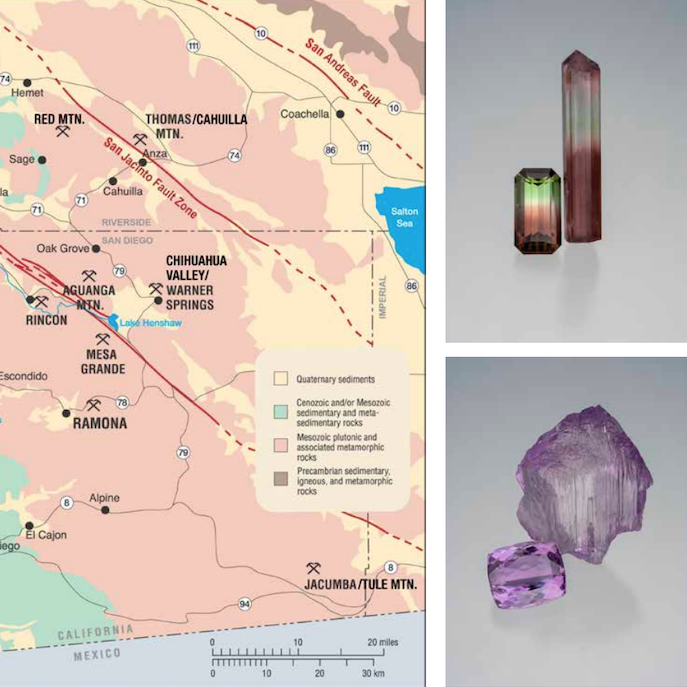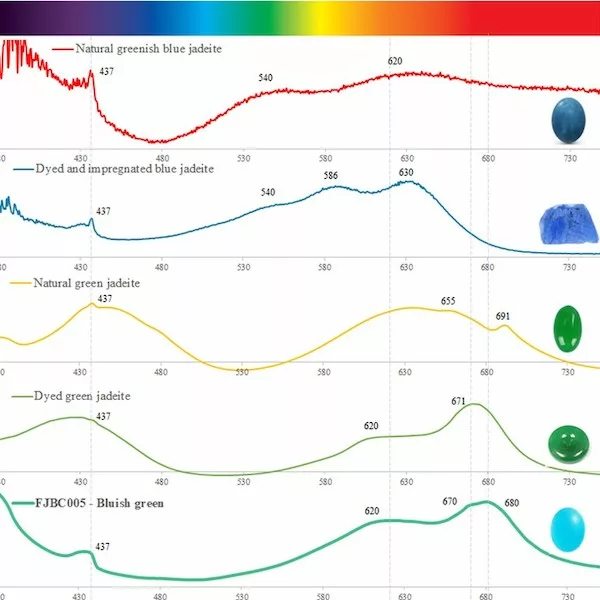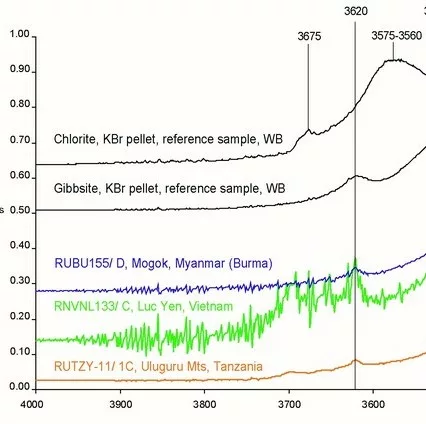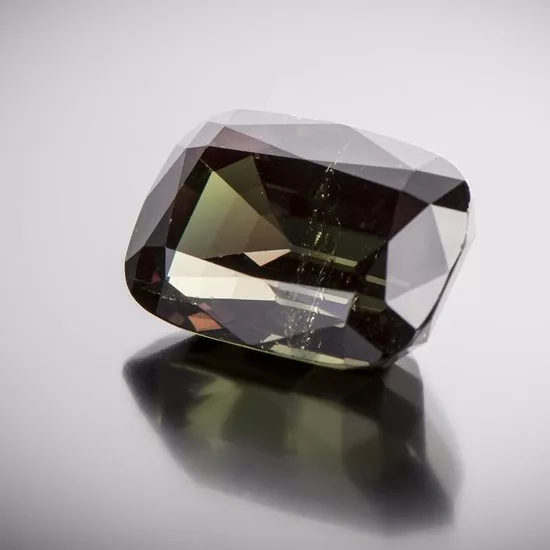A Review and Synthesis of the Geology and Gem Resources of Granitic Pegmatites in Southern California, USA
By Brendan M. Laurs
Keywords: Pegmatite, tourmaline, morganite, aquamarine, kunzite, spessartine, San Diego County, California
Introduction
Gem-bearing pegmatites in Southern California are hosted by the Peninsular Ranges batholith, and occur in ten districts in San Diego and Riverside counties (Figure 1a and Table 1). They are important historic sources of high-quality gem rough and world-class mineral specimens of various minerals, including tourmaline (Figure 1b), spodumene (Figure 1c), beryl, topaz and spessartine), and have also been mined for industrial materials (quartz, feldspar and Li minerals).
Most of the mining took place during the first decade of the twentieth century, and subsequently in the 1970s-1980s. Despite some changes in land-use policies, and increasing regulations and costs associated with mining, a few of the mines are still being worked today for gem rough and mineral specimens. Impressive examples of gemstones and crystals are found in numerous museums and important private collections, and also continue to circulate on the market. The tourmaline is revered for its pure vibrant pink and bicolored pink-green appearance, while the kunzite shows an attractive lavender coloration, and the spessartine exhibits a bright orange color even in relatively small sizes.
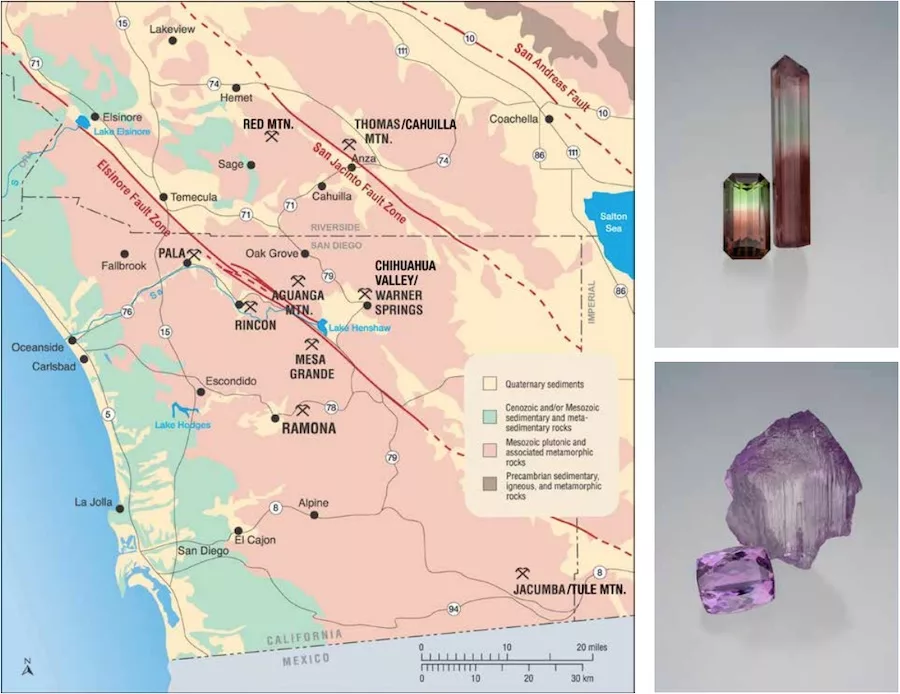
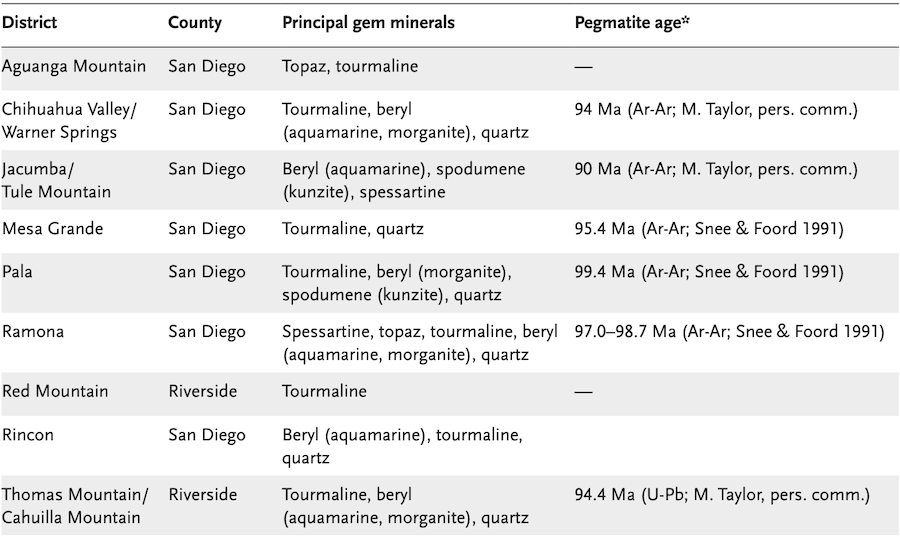
* The argon closure temperature for muscovite is ~350°C. Matthew Taylor is thanked for providing unpublished age data.
Pioneering geological and mineralogical studies of the pegmatites were done by Richard H. Jahns (e.g. Jahns & Wright 1951), John Hanley (1951), Dale R. Simpson (1960), and Eugene E. Foord (1976). More recently, various researchers have focused on the geological setting and petrogenesis of the pegmatites (e.g. Symons et al. 2009; Morton et al. 2018). In addition, summary descriptions of various S. California pegmatite localities were provided by Fisher (2002, 2011).
Geological History of the Peninsular Ranges Batholith and Characteristics of the Pegmatites
Dating by the 235U/207Pb and 40Ar/39Ar methods have yielded pegmatite ages ranging from 99.4 to 90 million years (Ma), younging to the east (see Table 1). Nearly all of the pegmatites are hosted by igneous rocks of the Peninsular Ranges Batholith (PRB), which extends from near San Jacinto Mountains in Riverside County southward into Baja California. The PRB has been broadly divided into western and eastern zones according to differences in the physical, compositional and isotopic properties of its plutons. These two zones are contiguous products of Cretaceous subduction (i.e. of the Farallon plate beneath the North American plate), which transitioned from a Mesozoic oceanic arc setting in the western PRB to a continental-margin arc setting in the eastern PRB (Hildebrand & Whalen 2014; Premo et al. 2014). Rocks of the western zone include weakly to moderately deformed ~128–120 Ma gabbros (and associated volcanics), ~118–115 Ma granodiorite–monzogranite plutons, and ~108–102 Ma quartz diorite–tonalite plutons (which are most abundant). Rocks of the eastern zone consist of large, undeformed, ~99– 92 Ma ‘La Posta’-type plutons that are compositionally zoned with a tonalite to granodiorite composition. The youngest of these intrusions (<95 Ma) are small (1–2 km) two-mica granites and associated pegmatites.
The economically important pegmatite districts (Pala, Mesa Grande, and Ramona) are hosted by gabbroic or tonalitic rocks in the western zone of the PRB. The source of these pegmatites has not been identified, while some of those of the eastern zone (i.e. in the Jacumba/Tule Mountain District) appear to be related to partial melting caused by heat from the La Posta pluton. Geological, geochemical and paleomagnetic evidence indicate that the pegmatites in both zones are broadly cogenetic, but differences in their age, composition and mineralization between the various districts suggests to the present author that they each formed independently from discrete local sources.
The pegmatites occur in groups of subparallel dikes and sills that were emplaced along a well-developed set of fractures (typically in gabbros and norites), which may have been produced by regional contraction during batholithic cooling. Although up to several hundred pegmatite bodies can be present in a particular district, only a few of them are economically important sources of gems and mineral specimens. The pegmatites dip shallowly to moderately (south)west, generally 10°–35°, and are typically several 10s of meters long and 2–8 m thick (exceptionally up to 30+ m thick). The best-quality minerals and gems occur in specific portions of the pegmatites, where they are concentrated in crystal-lined miarolitic cavities referred to as “pockets” by the miners. The pocket zones are most commonly located near the centerline or just below the quartz core of the pegmatites, and they range from several centimeters across to extensive, multiply-projecting, and branching cavities as much as 3 m or more.
Paleomagnetic data by Symons et al. (2009) indicate that at the time the San Diego Co. pegmatites formed, they were located near what is today the northwestern coastline of mainland Mexico (Sonora State). Rapid exhumation of the PRB, combined with recent uplift and northwest transport of the pegmatite districts along the San Andreas Fault system, are responsible for making these gem and mineral resources accessible to us today in Southern California.
References:
- Fisher, J., 2002. Gem and rare-element pegmatites of Southern California. Mineralogical Record, 33(5), 361–407.
- Fisher, J., 2011. Mines and minerals of the Southern California pegmatite province. Rocks & Minerals, 86(1), 14–35, https:// doi.org/10.1080/00357529.2011.537167
- Foord, E.E., 1976. Mineralogy and petrogenesis of layered pegmatite-aplite dikes in the Mesa Grande District, San Diego County, California. PhD thesis, Stanford University, Stanford, California, USA, 326 pp + 2 plates.
- Hanley, J.B., 1951. Economic Geology of the Rincon Pegmatites, San Diego County, California. California Division of Mines Special Report 7-B, 24 pp.
- Jahns, R.H., Wright L.A., 1951. Gem and Lithium-bearing Pegmatites of the Pala District, San Diego County, California. California Division of Mines Special Report 7-A. 72 pp. + 5 plates.
- Hildebrand, R.S., Whalen, J.B., 2014. Arc and slab-failure magmatism in Cordilleran batholiths II – The Cretaceous Peninsular Ranges batholith of southern and Baja California. Geoscience Canada, 41(4), 399–458, https://doi.org/10.12789/ geocanj.2014.41.059.
- Morton, D.M., Sheppard, J.B., Miller, F.K., Lee, C.-T.A., 2018. Petrogenesis of the cogenetic Stewart pegmatite-aplite, Pala, California: Regional implications. Lithosphere, 11(1), 91–128, https://doi.org/10.1130/l1026.1.
- Premo, W.R., Morton, D.M., Wooden, J.L., Fanning, C.M. 2014. U-Pb zircon geochronology of plutonism in the northern Peninsular Ranges batholith, Southern California: Implications for the Late Cretaceous tectonic evolution of Southern California. In D.M. Morton and F.K. Miller, Eds., Peninsular Ranges Batholith, Baja California and Southern California, Geological Society of America Memoir 211, 145–180, http:// dx.doi.org/10.1130/2014.1211(04).
- Shigley, J.E., Laurs, B.M. 2006. Pala Pegmatite District: Stewart, Pala Chief, and Elizabeth R Mines. Field trip guidebook, GIA Gemological Research Conference and the 4th International Gemological Symposium, San Diego, California, USA, 26–29 August, 12 pp.
- Simpson, D.R. 1960. Geology of the Ramona pegmatites, San Diego County, California. PhD thesis, California Institute of Technology, Pasadena, California, USA, 197 pp. + 4 plates.
- Snee, L.W., Foord, E.E., 1991. 40Ar/39Ar thermochronology of granitic pegmatites and host rocks, San Diego County, California: Geological Society of America Abstracts with Programs, 23(5), A479.
- Symons, D.T.A., Smith, T.E., Kawasaki, K., Walawender, M.J. 2009. Paleomagnetism of the mid-Cretaceous gem-bearing pegmatite dikes of San Diego County, California, USA. Canadian Journal of Earth Sciences, 46(9), 675–687, https:// doi.org/10.1139/e09-035.

